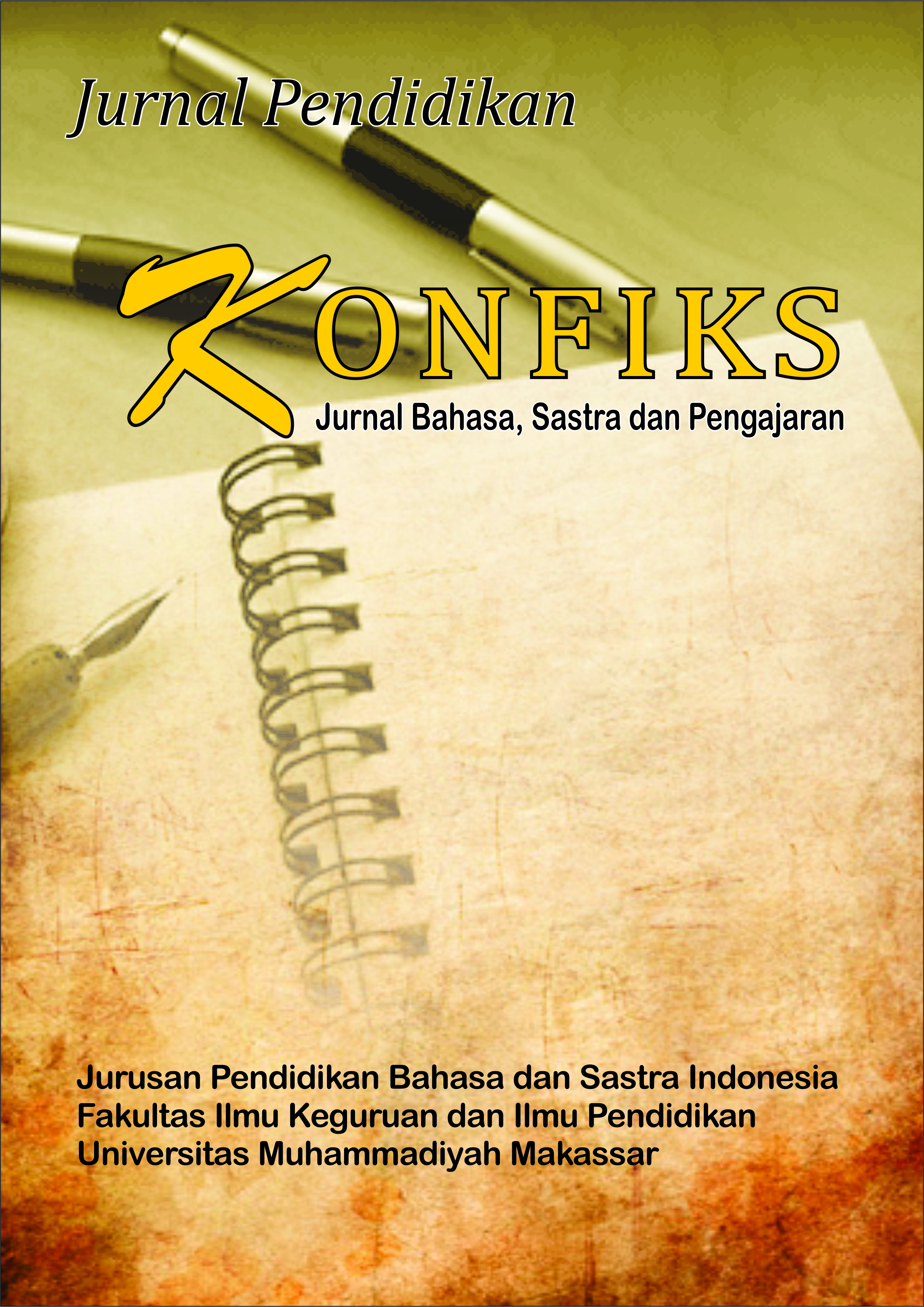TILISTIKA DALAM PUISI “KERIKIL TAJAM DAN YANG TERAMPAS DAN YANG PUTUS” KARYA CHAIRIL ANWAR
DOI:
https://doi.org/10.26618/konfiks.v2i1.395Abstract
Abstract
The problems addressed in this study, namely: (1) How is the form of assonance and alliteration in poetry collection of sharp gravel and deprived and the Disconnect work of Anwar? (2) How does the selection of the connotation and denotation in diction contained in a collection of poems sharp gravel and deprived and the Disconnect work of Anwar? (3) What is the meaning of style in a collection of poems sharp gravel and deprived and the Disconnect work of Anwar. The method in this research used deskriptiva qualitative. Data collection techniques used technique of record, because the data in the form of text. Based on this analysis we can conclude several things, namely: (1) The use or selection of language sounds used in Poetry Gravel sharp and deprived and the Disconnect work of Anwar, discovered the existence of assonance 'equation vowel' a widely used sound a, i, u, e, o. Alliteration 'equation consonant sounds used dalamPuisi Gravel sharp and deprived and the Disconnect work of Anwar is consonant / p /, / s /, / g /, / k /, / t /, / l /, / k /. / m / and /b/.(2) Diction in poetry sharp gravel and deprived and the Disconnect Anwar's work can be viewed in terms of vocabulary, diction, and denotation and connotation. (3) The use of force contained in the language of poetry Gravel sharp and deprived and the Disconnect work Chairil Anwaradalah (a) metaphor, (b) allusion, (c) hyperbole, (d) synesthesia, (e) allegory, (f) the personification, (g) fable (h) the symbolic, ( i) reps.
Keywords: Stilistika, diction, style, sound aspects
Abstrak
Permasalahan yang dibahas dalam penelitian ini, yaitu: (1) Bagaimana bentuk asonansi dan aliterasi dalam kumpulan puisi Kerikil tajam dan yang terampas dan yang Putus karya Chairil Anwar? (2) Bagaimana pemilihan konotasi dan denotasi dalam diksi yang terdapat dalam kumpulan puisi Kerikil tajam dan yang terampas dan yang Putus karya Chairil Anwar? (3)Bagaimanakah makna gaya bahasa dalam kumpulan puisi Kerikil tajam dan yang terampas dan yang Putus karya Chairil Anwar. Metode yang digunakan dalam penelitian ini adalah metode deskriptifkualitatif. Teknik pengumpulan data yang digunakan dalam penelitian ini adalah teknik catat, karena data-datanya berupa teks. Berdasarkan analisis ini dapat disimpulkan beberapa hal, yaitu: (1)Pemanfaatan atau pemilihan bunyi-bunyi bahasa yang dipergunakan dalam Puisi Kerikil tajam dan yang Terampas dan yang Putus karya Chairil Anwar, ditemukan adanya asonansi ‘persamaan bunyi vokal’ yang banyak dipakai bunyi a, i, u, e, o. Aliterasi ‘persamaan bunyi konsonan yang digunakan dalamPuisi Kerikil tajam dan yang Terampas dan yang Putus karya Chairil Anwar adalah bunyi konsonan /p/, /s/, /g/, /k/, /t/,/l/,/k/./m/ dan /b/.(2) Diksi dalam puisi Kerikil tajam dan yang Terampas dan yang Putus karya Chairil Anwar dapat ditinjau dari segi kosakata, pemilihan kata, dan denotasi serta konotasinya.(3)Pemakaian gaya bahasa yang terdapat dalam puisi Kerikil tajam dan yang Terampas dan yang Putus karya Chairil Anwaradalah (a) metafora, (b) alusio, (c) hiperbola, (d) sinestesia, (e) alegori, (f) personifikasi, (g) fabel (h) simbolik, (i) repetisi.
Kata kunci: Stilistika, diksi, gaya bahasa, aspek bunyi
References
Aminuddin. 1995. Stilistika Pengantar Memahami Bahasa Dalam Karya Sastra.
Semarang: IKIP Semarang Press.
Nurgiyantoro, Burhan. 2010 (Cet. ke-8). Teori Pengkajian Fiksi. Yogyakarta: Gajah Mada University Press.
Ratna, Nyoman Kutha. 2009. Stilistika, Kajian Puitika Bahasa, dan Budaya. Yogyakarta: Pustaka Pelajar.
Pateda, M. 2010. Semantik Leksikal. Jakarta: Rineka Cipta
Subroto, Edi D., dkk. 1992. Tata Bahasa Deskriptif Bahasa Jawa. Jakarta:Departemen Pendidikan dan Kebudayaan.
Sudjiman, Panuti. 1993. Bunga Rampai Stilistik. Jakarta: Pustaka Utama Grafiti.
Tarigan, Henry Guntur. 2009. Pengajaran Gaya Bahasa. Bandung: Angkasa.
Downloads
Published
Issue
Section
License
Authors who publish with this journal agree to the following terms:
The author owns the copyright and grants the journal rights for first publication with the work simultaneously licensed under a Creative Commons Attribution License which allows others to share the work with acknowledgment of the work's authorship and initial publication in this journal.
Authors may enter into separate additional contractual agreements for the non-exclusive distribution of the published journal version of the work (for example, posting it to an institutional repository or publishing it in a book), with acknowledgment of its initial publication in this journal.
Authors are permitted and encouraged to post their work online (for example, in institutional repositories or on their websites) before and during the submission process, as this can lead to productive exchanges, as well as earlier and larger citations of published work (See The Effect of Open Access).
Statement of Authenticity and Manuscript Copyright can be downloaded: Here
After filling in the statement letter, please send via e-mail: konfiks@unismuh.ac.id




.png)


